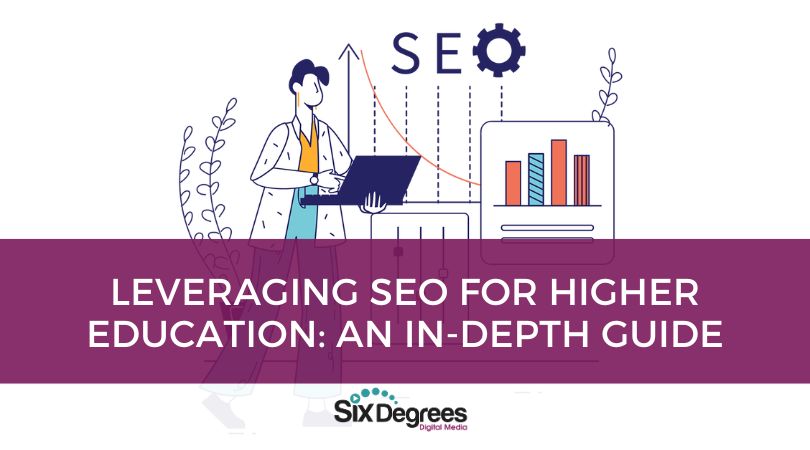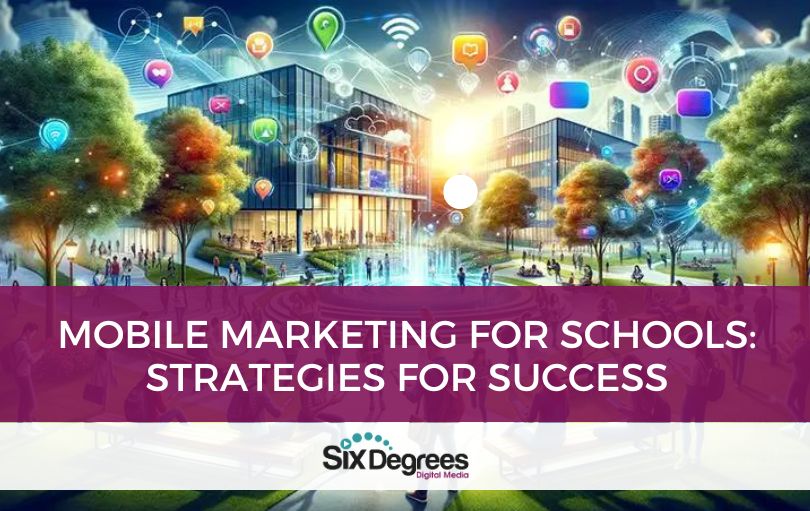
SEO involves optimizing your website to ensure it’s more visible to search engines. The benefit? It’s easier for potential students to discover your institution when searching for education options. A well-implemented SEO strategy can lead to enhanced brand recognition, increased application submissions, and higher enrollment figures, offering an edge in a competitive landscape.
This guide will delve into the importance of technical SEO, demonstrate how to craft SEO-friendly content, and discuss mobile-first strategies. We will examine link acquisition and explain the nuances in SEO approaches for in-person only, online-only, and hybrid institutions. Whether you’re a university, college, or a vocational school, there’s an SEO strategy ready to boost your institution’s digital marketing success.
The Role of SEO for Higher Education Institutions
SEO is a powerful tool in shaping the online presence of higher education institutions. Here are just a few ways it can benefit your school:
Building Visibility and Brand Awareness
Imagine a prospective student searching for “best engineering universities.” If your institution ranks on the first page of search results, the student will likely click on your website, and see what you have to offer. This increases your institution’s visibility, fostering brand awareness among potential applicants.
Impact on Application and Enrollment Rate
SEO drives organic traffic to your website, which means more prospective students browsing your programs and courses. For example, a well-optimized webpage for a Masters in Computer Science program can draw more attention, significantly boosting your application and enrollment rates.
Increasing International Student Reach
SEO transcends geographical barriers. A university in Australia, for instance, can use SEO to target potential students in Asia or Europe. By optimizing for keywords that international students are likely to use, or offering content in multiple languages, an institution can broaden its reach and attract a diverse student population.
Gaining Competitive Advantage
SEO is a strategic tool to gain an edge over competitors. If two universities offer similar programs but one has a stronger online presence via effective SEO, it’s likely to attract more digital-savvy applicants. For instance, if your institution optimizes for less competitive, long-tail keywords (e.g., “environmental science degree in New York”), you can rank higher for such searches, giving you a competitive advantage.
Understanding Technical SEO: An Essential Component of Your Digital Presence
Technical SEO refers to the optimization of website and server aspects that impact search engine crawling and indexing. This process lays the groundwork for your site to rank in search results. Here’s why it’s essential:
Website Structure, Speed, and Crawlability
A well-structured website makes it easier for search engines to crawl and index its pages, improving its visibility. Let’s say your university offers various courses across different faculties. A logical structure, where each faculty has its section, and individual courses fall under those sections, allows search engines to understand your site’s hierarchy better.
Website speed is also critical. Imagine a prospective student landing on your site only to leave because the page took too long to load. A swift, responsive website can improve user experience, leading to longer visits and higher chances of conversion.
XML Sitemaps and Robots.txt Files
XML sitemaps act as a roadmap for search engines, guiding them to essential pages on your site. For example, a sitemap could help Google find a new blog post on your website about an upcoming open house event, ensuring it’s indexed quickly.
Robots.txt files, on the other hand, tell search engines what not to crawl. For instance, you might want to exclude a page with sensitive information from being indexed.
Interpretation by Search Engine
Search engines use complex algorithms to analyze the technical elements of your website. They consider site structure, speed, sitemap presence, robots.txt files, and more to determine how well your site answers a user’s query. A technical error, like a broken link, can signal poor site quality, resulting in lower rankings. Conversely, a website free of technical issues sends positive signals to search engines, improving its likelihood of ranking well.
Importance of HTTPS for Security and SEO
HTTPS encrypts information sent between your site and the user, enhancing security. Imagine a prospective student submitting an application form on your site. HTTPS ensures this sensitive data is protected, fostering trust with the user.
Beyond security, HTTPS is a ranking signal for Google. If two websites have similar content and SEO, but only one uses HTTPS, the secure site will typically rank higher.
By optimizing these elements, institutions can ensure their website is not only attractive and useful to visitors but also easily understood and highly ranked by search engines—a crucial step in enhancing their online presence.
Content is King: Crafting SEO-Friendly Content for Higher Education
Content plays a pivotal role in SEO, driving traffic, engagement, and conversions on your website.
The Role of Keyword Research in Higher Education SEO
Keyword research is crucial for creating content that aligns with what your prospective students are searching for. For example, if keyword research reveals that “online MBA programs” is a common search term, creating a page dedicated to your institution’s online MBA offerings would be beneficial. This way, when students search for these programs, your institution will have a higher chance of appearing in the search results.
If you’re working hard to rank for keywords that no one is searching for, all of that effort will be done in vain, and you won’t see any increase in your enrollments.
Long-tail keywords—more specific search phrases—can be a goldmine in higher education SEO. They may have lower search volumes, but they often come with less competition and higher intent. For instance, a student searching for “undergraduate psychology program in Boston” is likely closer to enrolling than someone searching for “universities in the US.”
The Importance of Original, Quality Content
Search engines reward websites that offer valuable, unique content. Suppose your university published an in-depth study about the effects of online learning on student performance. This type of original content could rank well, bringing more visibility to your institution and demonstrating your commitment to advancing education.
Regularly publishing blog posts and articles on your site can help improve your SEO. It offers more pages to be indexed and provides opportunities to target more keywords. Think about the content that will be useful for prospective and current students and write what they will find valuable.
Using language that resonates with your target audience—students—can make your content more engaging. While some educational jargon might be necessary, balance it with student-friendly language. For instance, replacing “syllabus” with “what you’ll learn” can make your content more relatable.
SEO-oriented content creation can significantly boost your institution’s online visibility and connection with potential students. A thoughtful approach to keywords, user-friendly language, and consistent, original content can yield substantial dividends in the competitive landscape of higher education.
Embracing Mobile-First Strategies for Higher Education SEO
With over half of web traffic coming from mobile devices, having a mobile-optimized website is no longer optional—it’s a necessity. If your university’s website doesn’t display correctly or is hard to navigate on a mobile device, you risk losing a significant number of potential students.
Google now primarily uses the mobile version of a website for indexing and ranking. If you have a fantastic desktop website but a poorly designed mobile site, you could drop in the search rankings, losing visibility and potential applicants.
Implementing a responsive design—one that adjusts to fit different screen sizes—is a great start. Also, ensure your site’s menus are easy to navigate on a smaller screen, and that forms, like those for applications or inquiries, are easy to fill out on mobile.
Make sure you prioritize speed as well. Mobile users expect websites to load quickly. A delay of even a few seconds can lead to a prospective student abandoning your site. Moreover, a smooth, enjoyable mobile experience can boost engagement, keeping potential students on your site longer.
In the mobile era, ignoring mobile optimization can limit your institution’s reach and potential. By embracing mobile-first strategies, you can engage with prospective students on the devices they use the most, widening your institution’s appeal and accessibility.
Harnessing the Power of Backlinks in SEO for Higher Education
Link acquisition, or the process of gaining backlinks (incoming links from other websites), is a powerful SEO strategy. It acts as a vote of confidence from one site to another, influencing your site’s visibility and credibility.
Search engines view backlinks as an endorsement of your site’s content. The more high-quality backlinks your site has, the more reputable it appears, which can positively impact your search rankings. For instance, if a respected educational resource site links to a research article published on your university’s website, it can significantly enhance your SEO.
So, how do you get backlinks? Guest blogging on reputable sites relevant to higher education can earn backlinks and expose your institution to a wider audience. Partnerships with other institutions can also lead to reciprocal backlinking—a win-win for both parties.
Another strategy is creating high-quality, shareable content on your site, such as infographics or whitepapers. This content can naturally attract backlinks if other sites find it valuable and choose to share it.
While links from social media sites are typically ‘nofollow’ (meaning they don’t directly impact search rankings), they still play a role in link acquisition. If your institution shares a new blog post on its Facebook page and it’s shared by hundreds of users, the chances increase that someone might link to it from their website.
By understanding the importance of link acquisition and leveraging various strategies to secure high-quality backlinks, higher education institutions can enhance their SEO performance, improve their online reputation, and attract more potential students.
SEO Strategies for Different Types of Higher Education Institutions
Not all higher education institutions are alike, and neither are their SEO strategies. Let’s explore the differences and how each type can leverage SEO to their advantage:
SEO for In-Person Only Institutions
For institutions where education is primarily in-person, local SEO is crucial. Local SEO focuses on improving visibility in local search results, which is beneficial for institutions targeting students in a specific geographical area. For example, a city college might optimize for keywords such as “colleges in [city name]” to attract local students. Additionally, they should ensure their institution is listed in Google My Business, which can help them appear in local search results and Google Maps.
SEO for Online-Only Institutions
For online-only schools, their digital footprint is their main asset. Their SEO strategy should aim to maximize online visibility globally, as their potential student base isn’t restricted by location. They might target broader, high-volume keywords such as “online bachelor’s degree” or “accredited online MBA programs”. A strong content strategy can also play a big role, with valuable resources, such as articles about online learning, providing additional opportunities to attract and engage prospective students.
SEO for Hybrid Institutions
These institutions, offering a blend of in-person and online education, should use a mix of the above strategies. They can utilize local SEO to attract in-person students while also maximizing their online visibility to draw in remote learners. A well-rounded keyword strategy, targeting both local and general terms related to their courses, would be beneficial.
Tailoring your SEO strategy accordingly can lead to significant benefits. By considering whether you’re in-person only, online-only, or a hybrid institution, you can better align your SEO strategy with your target audience, maximizing your visibility and impact.
The Future of SEO in Higher Education
As we delve deeper into the digital age, SEO continues to evolve, demanding continuous adaptation and innovation from higher education institutions. This means staying current with SEO best practices and Google’s frequent algorithm updates to ensure your institution remains competitive in the online space.
There are several potential trends we might see in SEO for higher education. For instance, voice search optimization could become more prevalent as more students begin using digital assistants like Siri and Alexa for online searches. Also, as Artificial Intelligence becomes more sophisticated, it could lead to even more personalized search results, requiring an enhanced focus on creating high-quality, user-centered content.
Another trend we’re already seeing is the increasing importance of E-A-T (Expertise, Authoritativeness, Trustworthiness) in Google’s ranking factors. This emphasizes the need for educational institutions to showcase their expertise and credibility through their online content.
Moreover, with the growing number of online and hybrid learning options, institutions must prioritize their digital presence more than ever. The COVID-19 pandemic has accelerated this trend, with more students considering online education than in the past. This means institutions must refine their SEO strategies to stand out in an increasingly crowded online space.
SEO plays an integral role in connecting students with the right institutions. It’s a critical tool for increasing your institution’s visibility, reaching potential students, and ultimately, shaping the future of education. By understanding and implementing effective SEO strategies, higher education institutions can ensure they’re not just keeping pace with the digital revolution, but leading the charge. Remember, a well-planned SEO strategy is more than just a marketing tactic—it’s an investment in your institution’s future. Book a complimentary strategy session to get insights on an SEO strategy for your institution.












